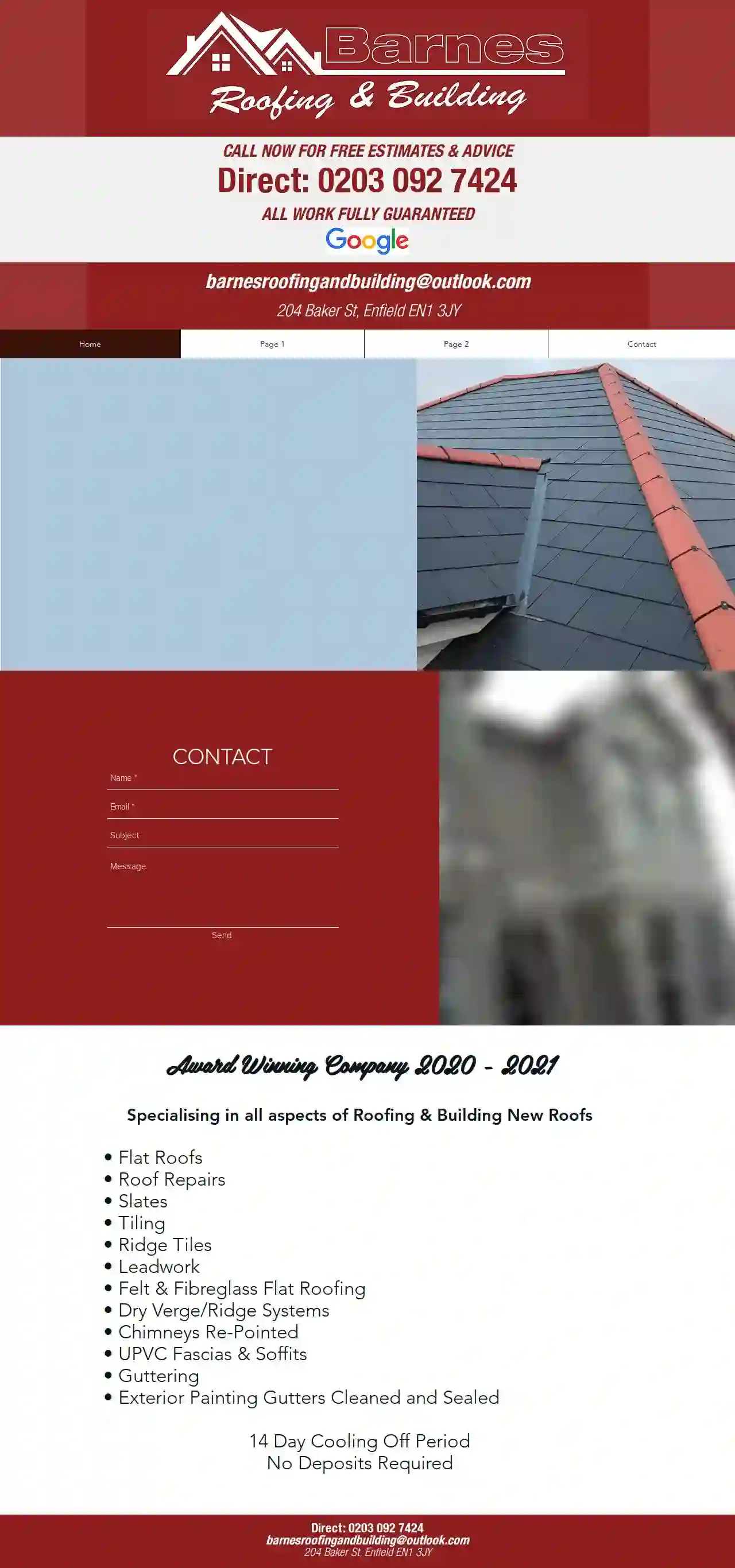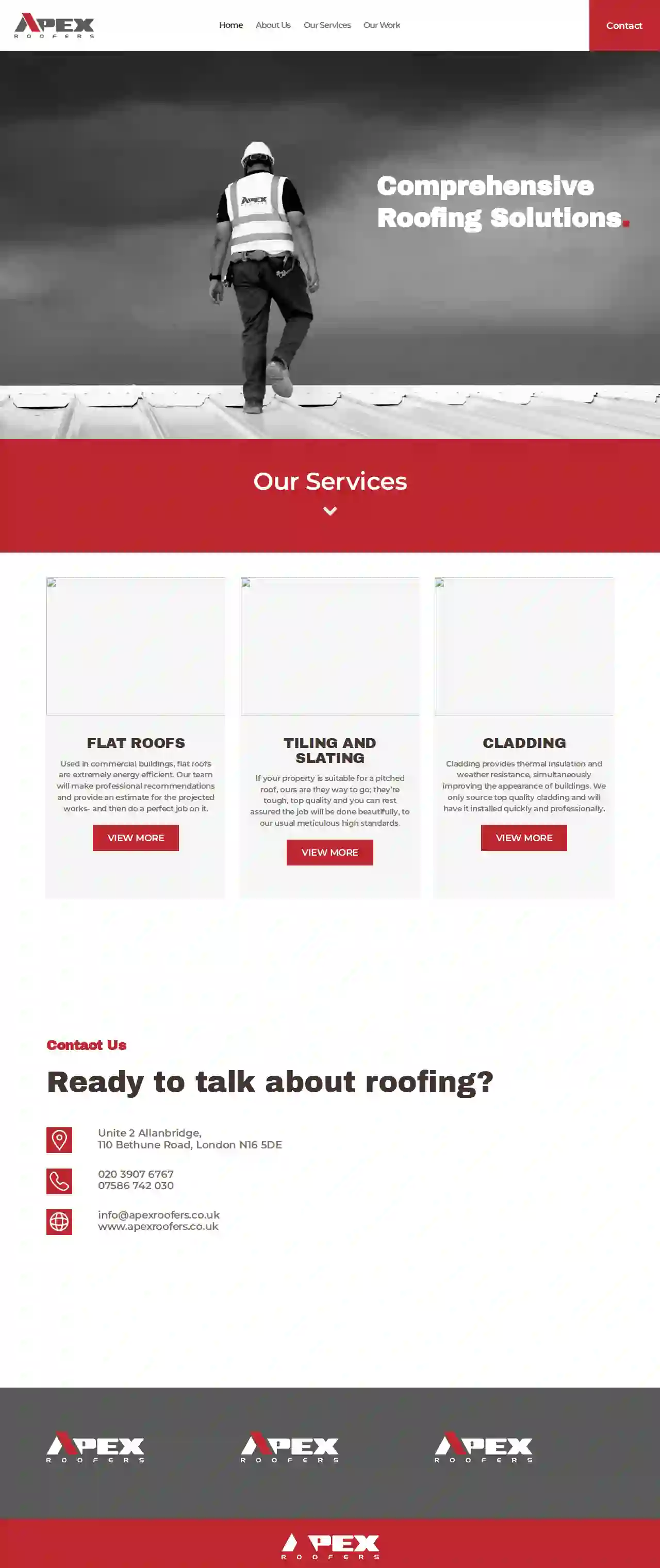Flat Roof Installers Islington
Top Flat Roof Installer in Islington
Get 3 FREE Flat Roofing Company quotes for your project today! Compare profiles, reviews, accreditations, portfolio, etc... and choose the best deal.

Barnes Roofing & Building
4.39 reviews204 Baker St, Enfield, EN1 3JY, GBAward Winning Company 2020 - 2021. Specialising in all aspects of Roofing & Building New Roofs. We offer a wide range of services including Flat Roofs, Roof Repairs, Slates, Tiling, Ridge Tiles, Leadwork, Felt & Fibreglass Flat Roofing, Dry Verge/Ridge Systems, Chimneys Re-Pointed, UPVC Fascias & Soffits, Guttering, and Exterior Painting. Gutters Cleaned and Sealed. 14 Day Cooling Off Period. No Deposits Required.
- Services
- Why Us?
- Gallery
Get Quote
Apex Roofers Ltd
4.935 reviewsUnite 2 Allanbridge, 110 Bethune Road, London, N16 5DE, GBComprehensive Roofing Solutions. Our Services FLAT ROOFS Main ServicesUsed in commercial buildings, flat roofs are extremely energy efficient. Our team will make professional recommendations and provide an estimate for the projected works- and then do a perfect job on it. VIEW MORE TILING AND SLATING Main ServicesIf your property is suitable for a pitched roof, ours are they way to go; they’re tough, top quality and you can rest assured the job will be done beautifully, to our usual meticulous high standards. VIEW MORE CLADDING Main ServicesCladding provides thermal insulation and weather resistance, simultaneously improving the appearance of buildings. We only source top quality cladding and will have it installed quickly and professionally. VIEW MOREContact UsReady to talk about roofing? Unite 2 Allanbridge,110 Bethune Road, London N16 5DE 020 3907 676707586 742 030 [email protected]
- Services
- Why Us?
- Gallery
Get Quote
Zinc Roofing and Cladding Contractors in London.
51 reviewsLondon, GBZinc Contractors are a fully qualified and highly skilled team of builders and roofers dedicated to providing the highest standards of workmanship to all our customers. Established in 2002, we specialize in zinc roofing and cladding, serving South London areas such as Battersea, Clapham, Chelsea, Balham, Surrey, Sutton, Cheam, Morden, Wimbledon, and Raynes Park. We are experts in installing, maintaining, and repairing zinc roofs and cladding systems across London. Zinc roofing is a durable and corrosion-resistant roofing material known for its long lifespan, low maintenance, and unique aesthetic appeal as it develops a distinctive patina over time. Zinc cladding is a popular architectural choice for building exteriors, valued for its durability, corrosion resistance, and aesthetic appeal. It also develops a protective patina, enhancing its weather resistance. At Zinc Contractors, we offer a comprehensive range of services to meet your zinc roofing and cladding needs, including: * **Full Metal Zinc Roofing:** Installation, maintenance, and repair of roofs using zinc as the primary roofing material. * **Zinc Cladding:** Application of zinc as an external layer to protect and enhance the appearance of a building's façade. We pride ourselves on our design expertise, installation skills, material knowledge, maintenance and repair capabilities, compliance with building standards, and commitment to environmentally friendly practices.
- Services
- Why Us?
- Gallery
Get Quote- Ha
Hamilton Roofing & Building Ltd
4.25 reviewsLondon, GB- Services
- Why Us?
Get Quote - B
B & B Roofing
4.25 reviewsLondon, GB- Services
- Why Us?
Get Quote - FD
FD Roofing and Building
4.69 reviewsLondon, GB- Services
- Why Us?
Get Quote - To
Topside Roofing Ltd
58 reviewsLondon, GB- Services
- Why Us?
Get Quote - Le
Lead-Tech Roofing
2.89 reviewsLondon, GB- Services
- Why Us?
Get Quote - HR
HR Roofing Specialists Ltd
517 reviewsLondon, GB- Services
- Why Us?
Get Quote - B&
B&S Roofing Specialist & Property Maintenance
518 reviewsLondon, GB- Services
- Why Us?
Get Quote
Over 12,314+ Roofing Contractors registered
Our roofing pros operate in Islington & surrounding areas!
Roofyng.co.uk has curated and vetted the Best Roofers near Islington. Find a reliable pro today.
Flat Roof Installation FAQs
- Preventing Ponding Water: The slope directs water towards drains, preventing accumulation and potential leaks.
- Extending Roof Lifespan: Protects the roof membrane from prolonged water exposure, increasing its lifespan.
What is a roof drain, and why is it important for flat roofs?
Can I install a flat roof myself?
What are the fire ratings for flat roofing materials?
What is a tapered insulation system, and why is it important for flat roofs?
What is a roof drain, and why is it important for flat roofs?
Can I install a flat roof myself?
What are the fire ratings for flat roofing materials?
What is a tapered insulation system, and why is it important for flat roofs?
- Preventing Ponding Water: The slope directs water towards drains, preventing accumulation and potential leaks.
- Extending Roof Lifespan: Protects the roof membrane from prolonged water exposure, increasing its lifespan.